The 2002 Jeep Liberty is considered by most diehard Jeepers the beginning of the end. Out went the boxy, rugged Jeep Cherokee XJ, and in its stead came a soft, round SUV with an uninspiring powertrain and — worst of all — independent suspension. This video comparison between the first four generations of Jeep Grand Cherokee shows why diehard Jeepers were so disappointed.
Before the Land Cruiser folks get upset, I’ll admit that, for lots of off-road scenarios, independent suspension is superior to a solid axle. In fact, I said the current most capable off-road vehicle in production is the Ford Bronco Raptor, which has IFS!
But, for low-speed off-roading, a solid axle is — in my opinion as a longtime off-roader and engineer — usually superior. At least, in passenger vehicles, that is.
It’s a combination of factors. First, a solid axle, with its basic tube design and serviceable/durable universal joints in the axle shafts, tends to be a more durable and repairable option for off-road trails. Second, a solid axle design is easier to lift than an independent suspension design since the only change in driveline angle is that of the driveshafts, which tend to be long and therefore not as steep as halfshafts (which take on a steeper angle when you lift an independent suspension). Third, there’s articulation.
And while I could make a list about how IFS is superior in some ways (less unsprung weight means going fast, especially on uneven sandy terrain, yields more traction and is about 100000x more comfortable), right now I just want to show you this random video I found of a little suspension/traction comparison between the first four Jeep Grand Cherokee generations: ZJ, WJ, WK, and WK2.
As a bit of an introduction, the ZJ was a huge deal back in its day. It took a formula pioneered (pun intended) by the Jeep Cherokee XJ — pairing a unibody with two solid axles — and built upon it. It kept the XJ’s track width, extended the wheelbase a bit, fixed the XJ’s cooling system inadequacies, and took the XJ’s Quadra-Link front suspension and adapted it to the rear, creating the Quadra Coil. The Quadra Coil went on to become the standard for off-road rear suspension designs, with everything from the Land Cruiser, Bronco, 4Runner, FJ Cruiser and so many others adopting the excellent suspension layout consisting of a track bar, two upper control arms, two lower control arms, coil springs and shocks (some separate, some coilovers).
In fact, the Jeep ZJ would go on to be the only Jeep ever to pair a relatively lightweight and stiff unibody design with a fully coil-sprung five-link suspension front and rear. (Some call it a four-link, ignoring the track bar/panhard rod). Here you can see the ZJ’s excellent suspension setup, courtesy of suspension seller Super Pro:
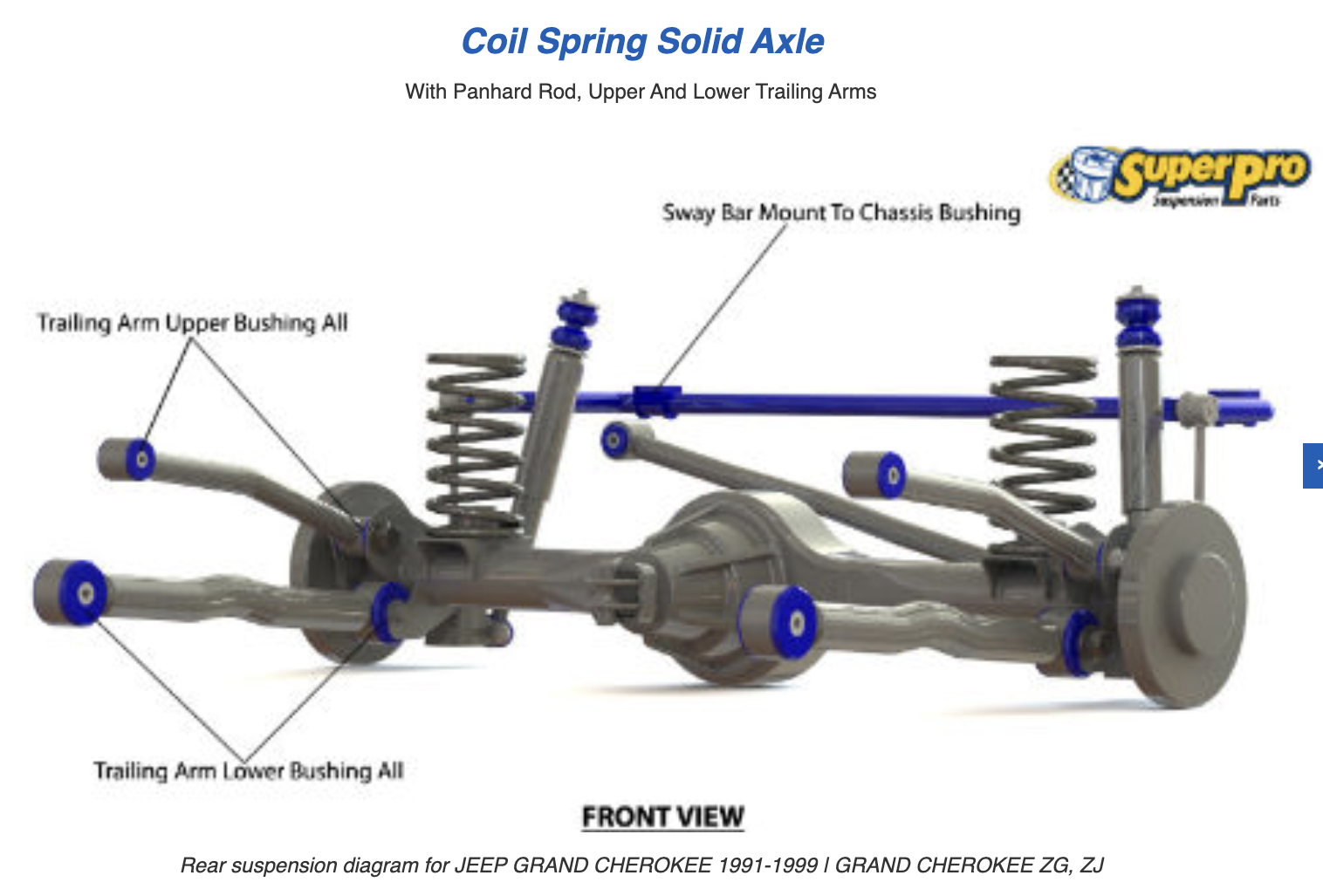
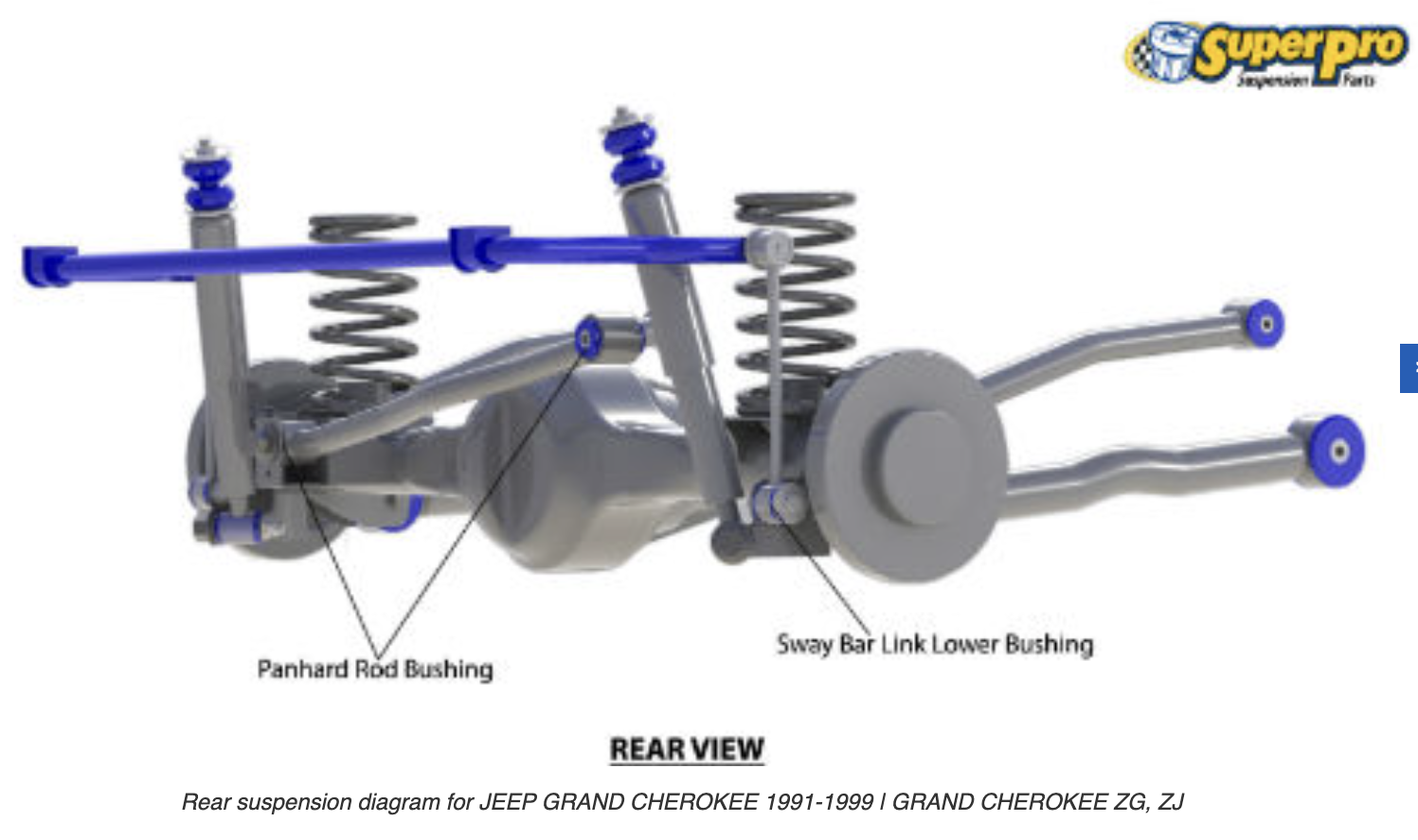
You’ll notice two lower control arms (or trailing arms), which are there to place the axle in the longitudinal direction (i.e. fore-aft), you’ll notice a track bar/panhard bar that places the axle in the lateral direction, and you’ll see two upper control arms/trailing arms to prevent axle wrap (i.e. the axle twisting) when braking or acceleration.
Here you can see that this is essentially the front suspension, but flipped around:
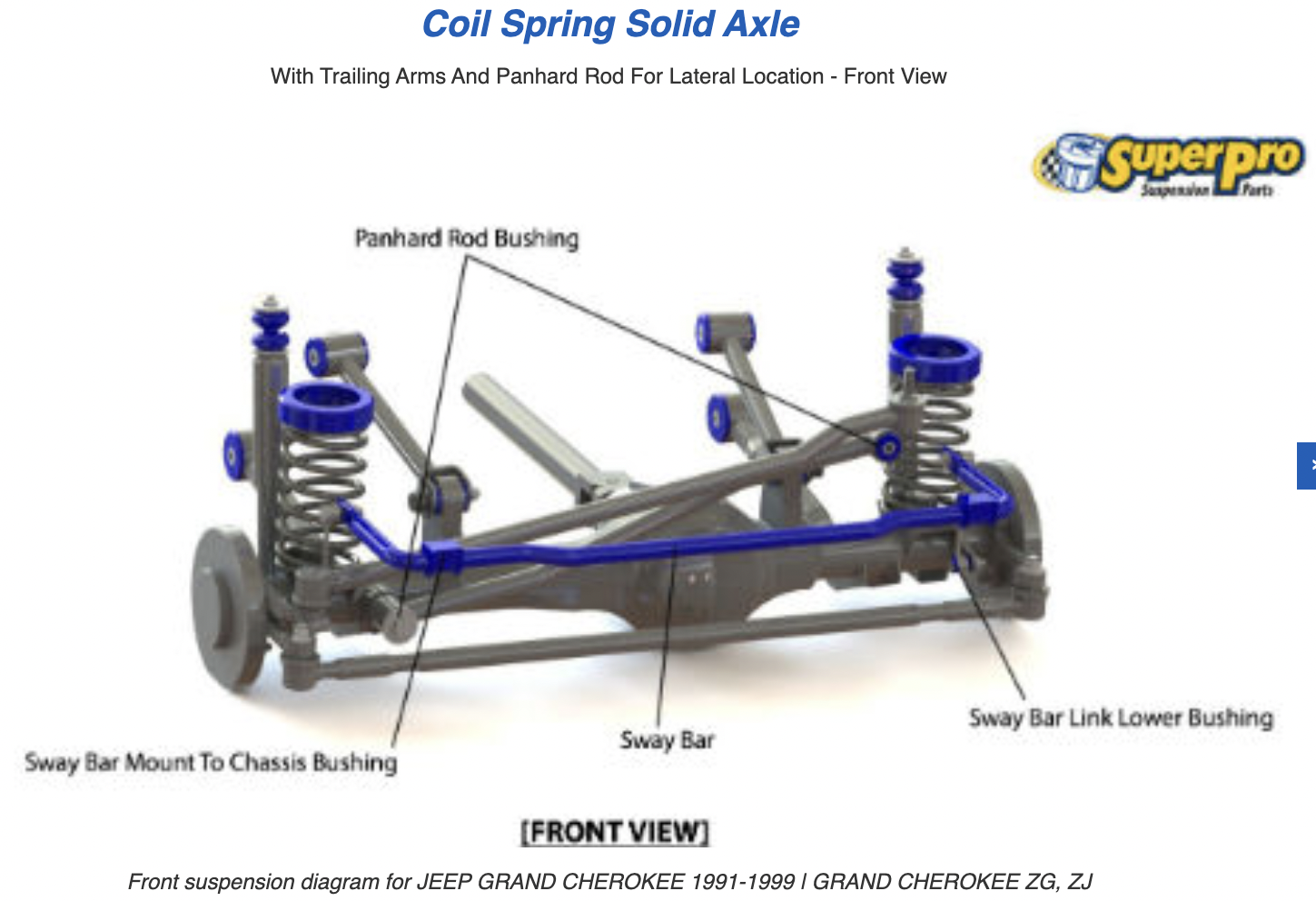
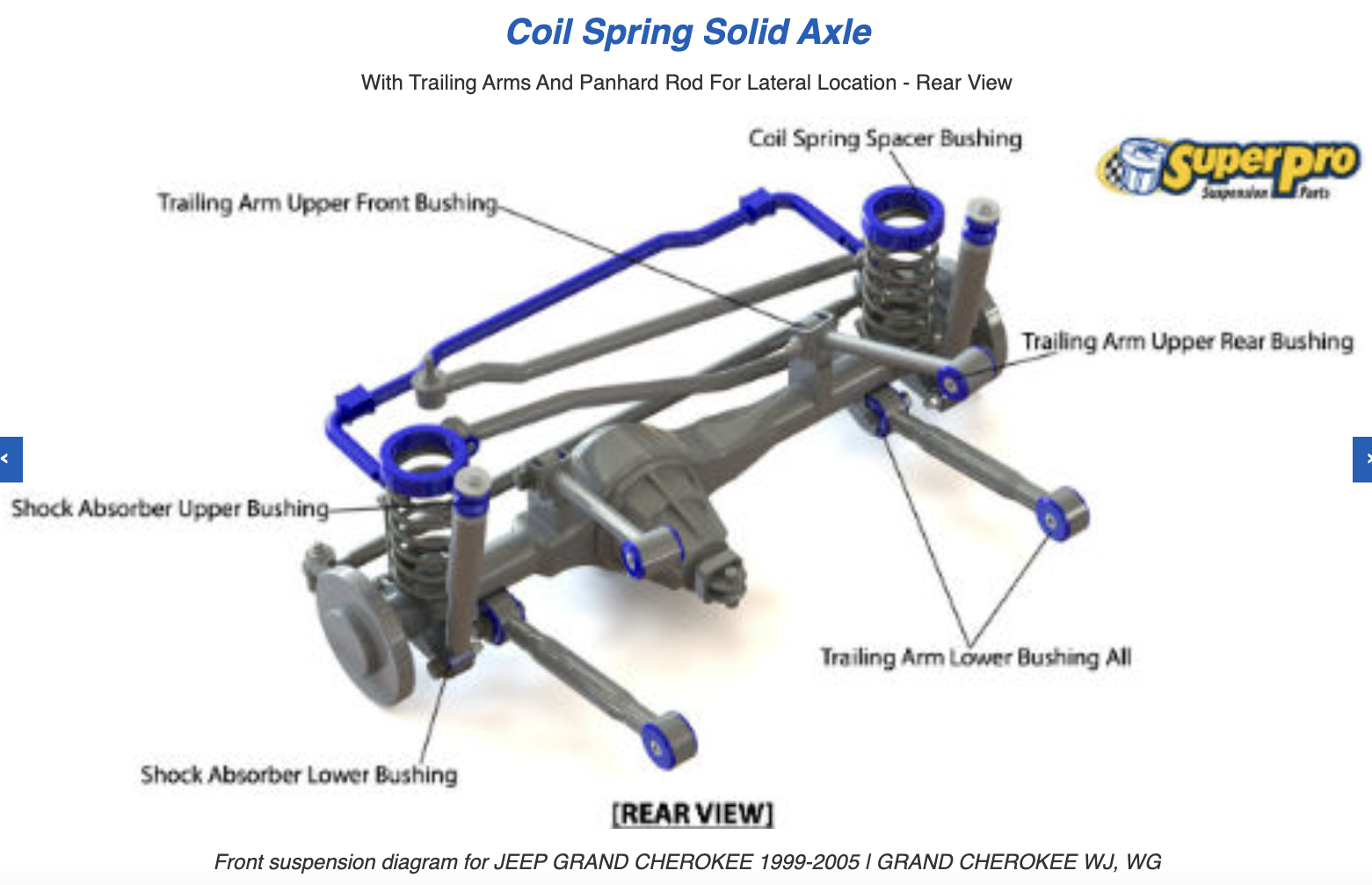
This sensational suspension design — which offers a ratio of comfort:suspension articulation never before seen in a dual solid axle vehicle — would never be seen again on a unibody Jeep, though the ZJ’s successor, the WJ, offered a strange variant of the design. Instead of having two upper control arms in the back, the WJ offered a single triangulating arm that attached to the top of the differential pumpkin via a ball joint:
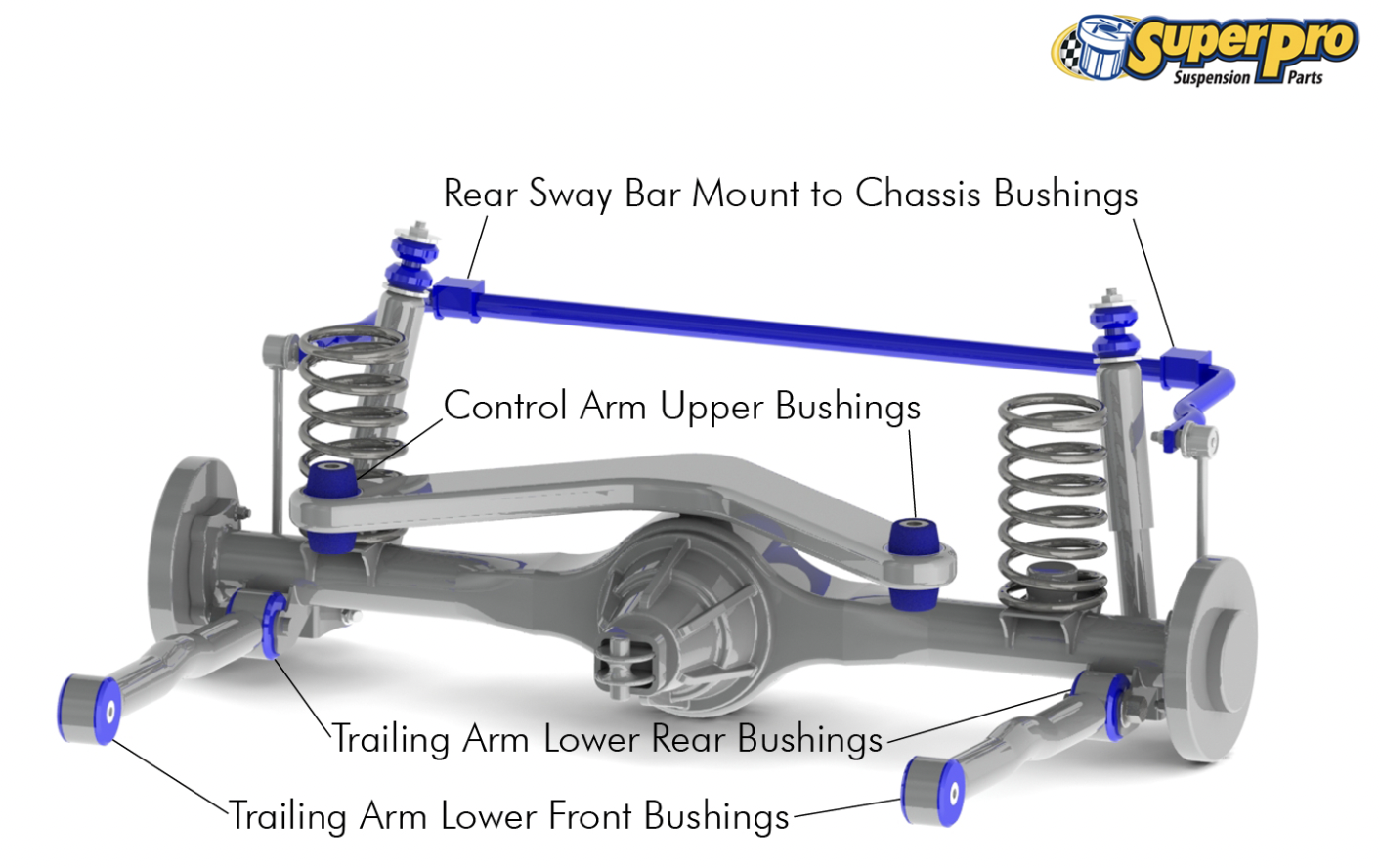
This design works essentially the same way as the dual upper control-arm design, though the way the bushings/ball joints allow freedom of motion is a bit different than the way the ZJ’s upper control arm bushings flex to allow motion. But again, it’s similar.
In 2005, the WJ went away and was replaced by the WK, which reverted back to the ZJ’s dual control arm rear suspension, and then replaced the solid front axle with an independent suspension setup like this:
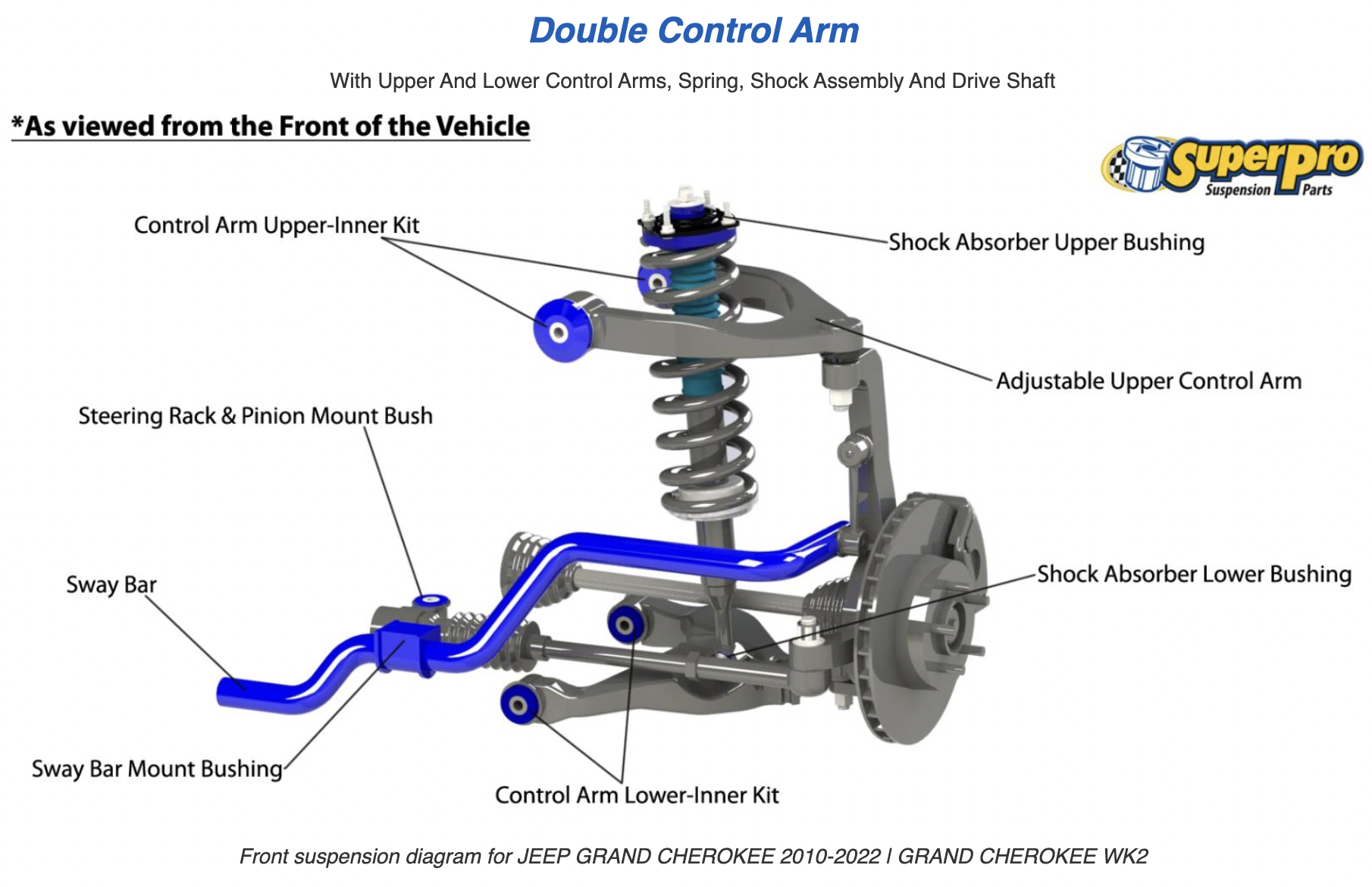
And then in 2011, the Jeep WK2 came with a fully independent suspension setup, appending that front suspension shown above with a fully independent rear suspension like this one:
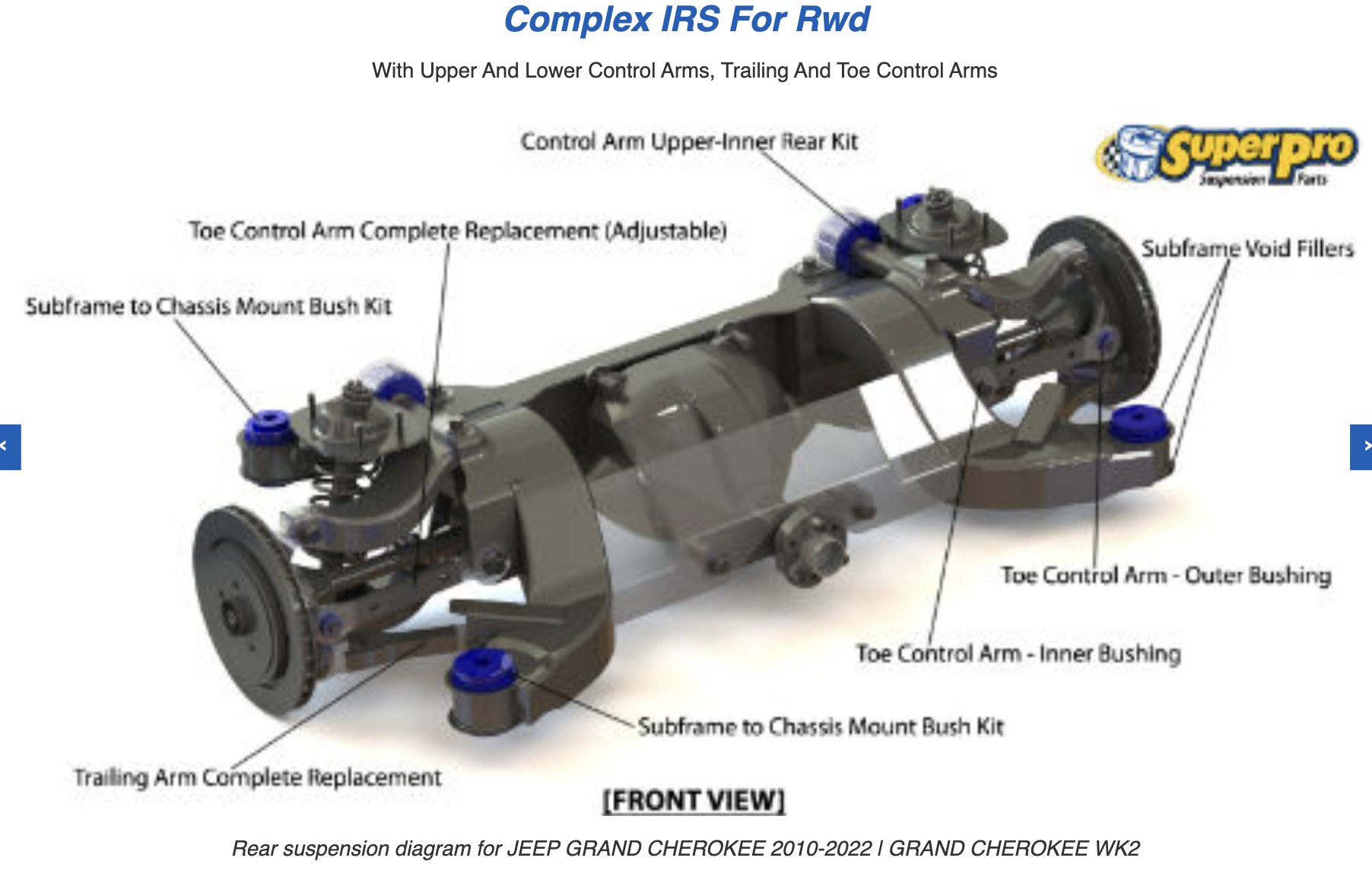
In terms of off-road articulation, solid axles — at least on production vehicles — tend to outperform independent suspension setups. And I’m not just talking about overall wheel travel, I’m talking about the way a vehicle flows over the terrain: cross articulation.
Our suspension engineer-contributor Huibert Mees broke it down in his article “Our Suspension Engineer’s Take On The ‘Solid Axle vs Independent Suspension’ Off-Road Debate,” writing:
The ability to keep all tires on the ground means having a lot of something called “cross articulation,” This refers to the ability of the axles to twist in opposite directions. It’s measured with a ramp as shown by this Jeep here and is measured with something called the Ramp Travel Index (RTI):
[…]
The reason why the Jeeps are still better for RTI is likely because of differences in available wheel travel and the stiffness of the springs. It’s pretty easy to design a solid axle to have lots of wheel travel. Independent suspensions have limits in how much angle the halfshaft CV joints can tolerate and how much articulation you can get out of the ball joints. Both of these limit how much travel you can design into an independent suspension. Without knowing the exact values for travel and spring rates for both vehicles it is difficult to know for sure, but once the stabars are disconnected, the only thing limiting RTI would be available wheel travel and spring stiffness.
In case you’re curious, here’s what an RTI ramp looks like, and how much better a stock solid axle XJ does over a fully independent suspension-equipped KL Cherokee (the successor to the “beginning of the end” KJ Liberty I started this article out with:
Anyway, back to the reason why I wrote this article in the first place: Someone compared four generations of Jeep Grand Cherokee! That’s just cool.
And as with the old vs. new Cherokee comparison shown in the video directly above, the new vehicles have better traction control systems, while the old vehicles offer better articulation (and with aftermarket locking differentials would be far superior on the terrain in question).

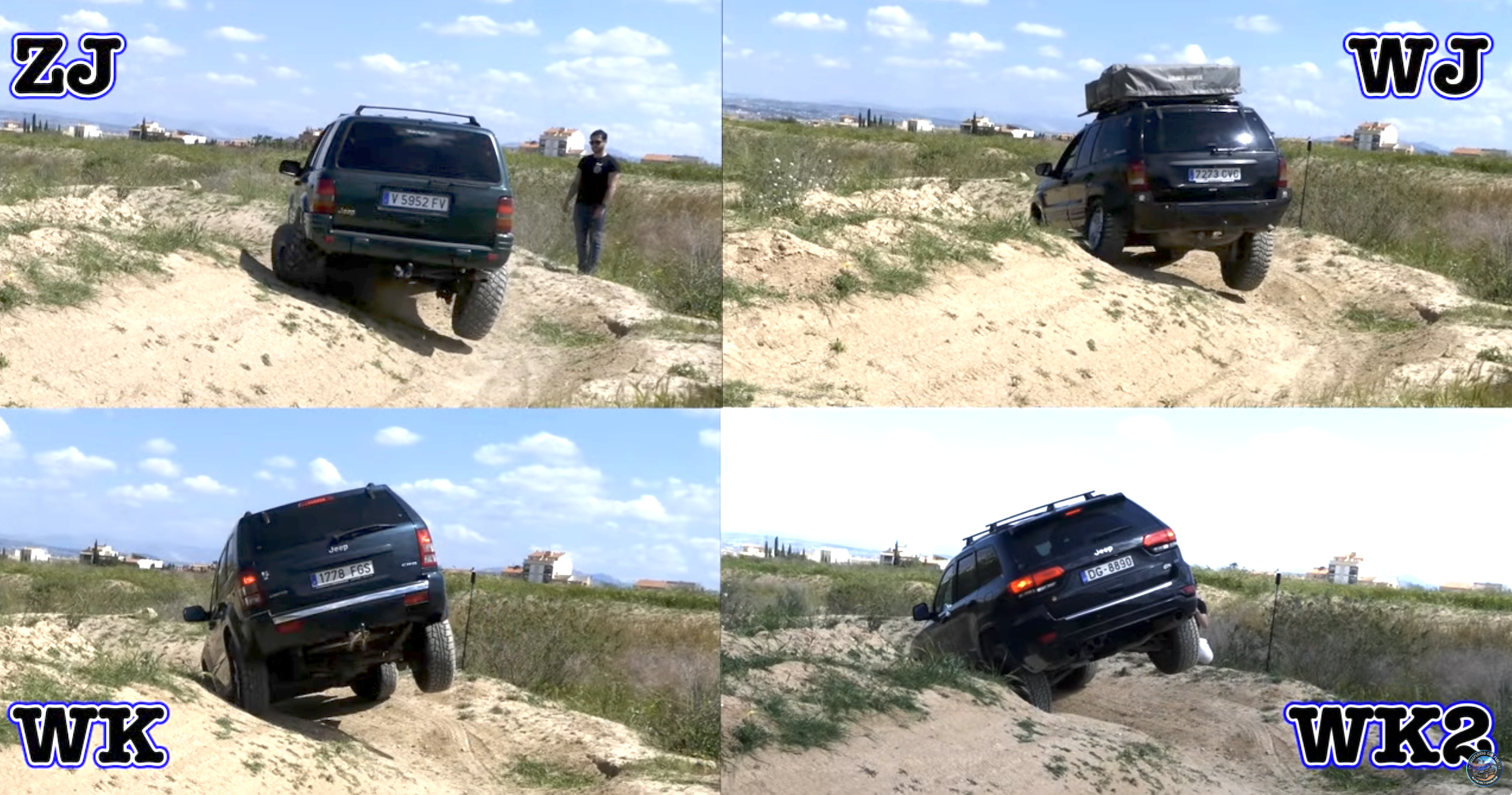
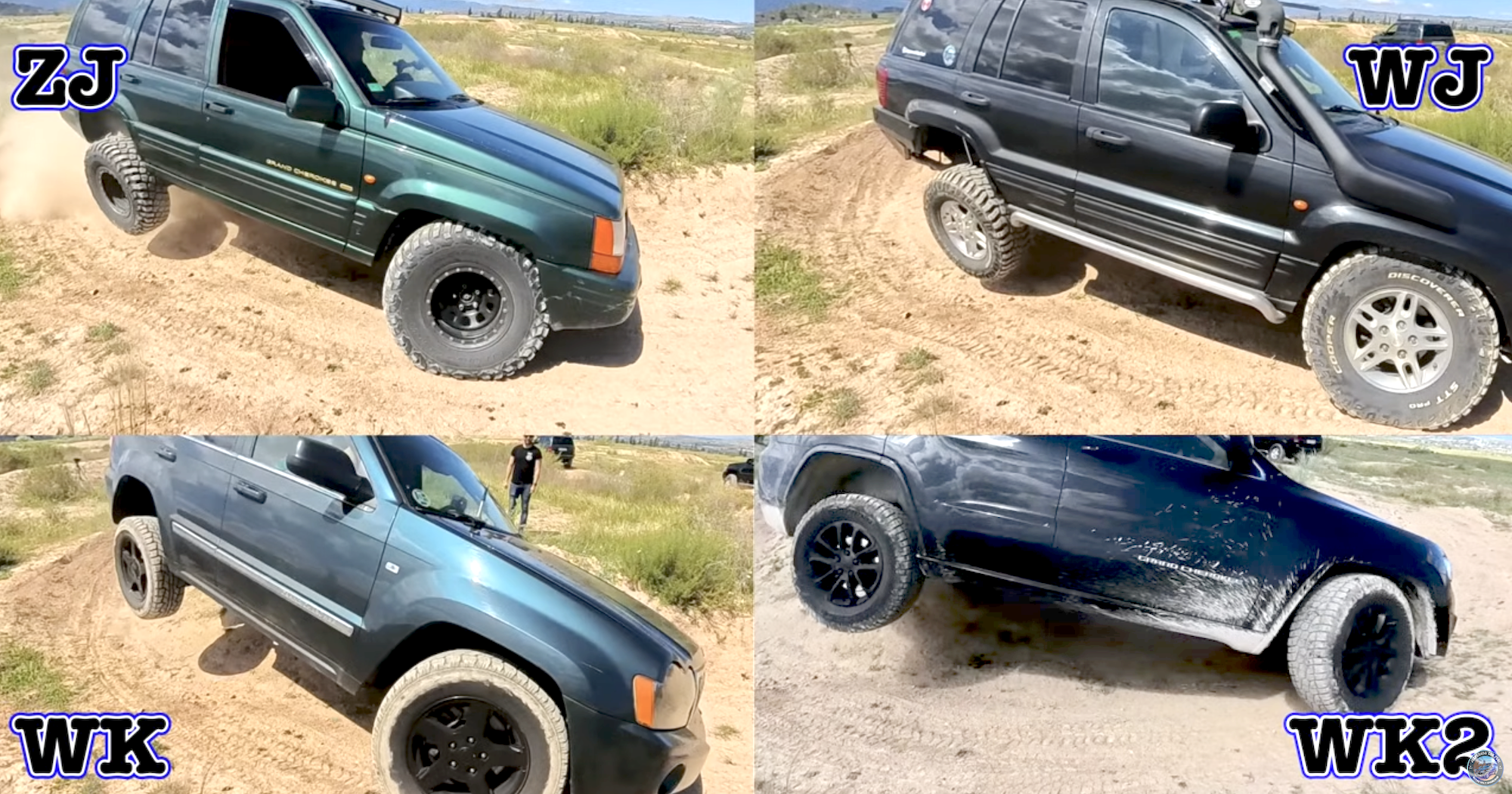
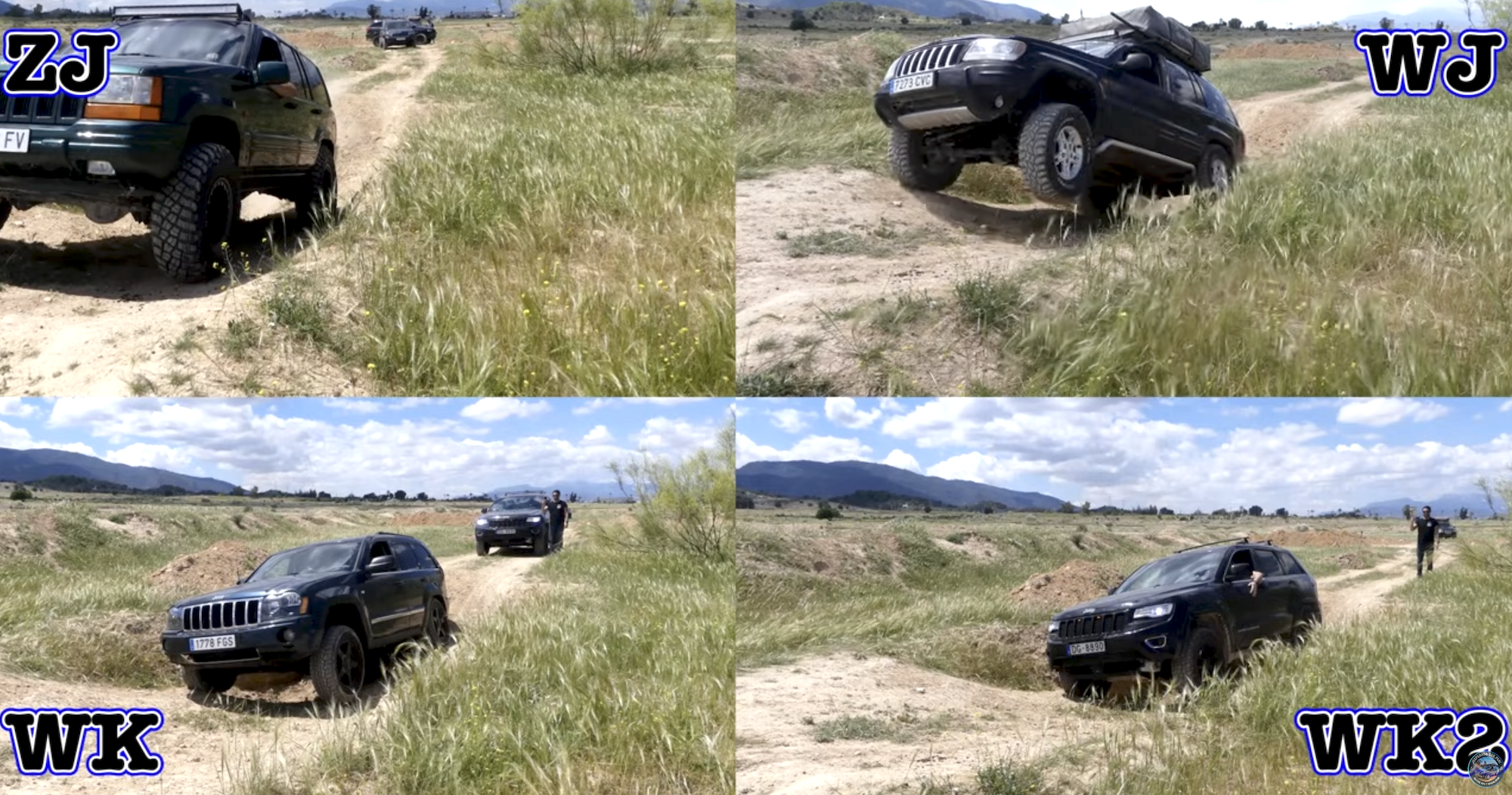
The YouTube channel that shot this comparison, Jeepeando Con Peri, did a great job showing just how much more stable the first two generations of Grand Cherokee (the ones equipped with two solid axles) are than the third and fourth-gens. And even the gap between the rear solid axle-equipped third-gen WK and the fully independent suspension-equipped WK2 is significant.
Just look at how high the WK and WK2’s wheels get off the ground! That’s not only an issue with stability (and as a drive, this tippyness is disconcerting), but it’s also a traction issue. A tire not on the ground cannot help propel a vehicle forward.
The newer computerized traction control systems keep power to the wheels that are still on the ground, so even the less flexy vehicles are able to handle this undulating dirt course. The ZJ’s Viscous Coupling-based primitive four-wheel drive system holds it back a bit, though some momentum helps the vehicle get through all the obstacles without issue.
The best performer, as you can see in the video, is actually the WJ, because it combines a state-of-0f-the-art-as-of-1999 traction control system with two highly articulating axles, resulting in what looks like the easiest little off-road stroll that driver has ever seen.

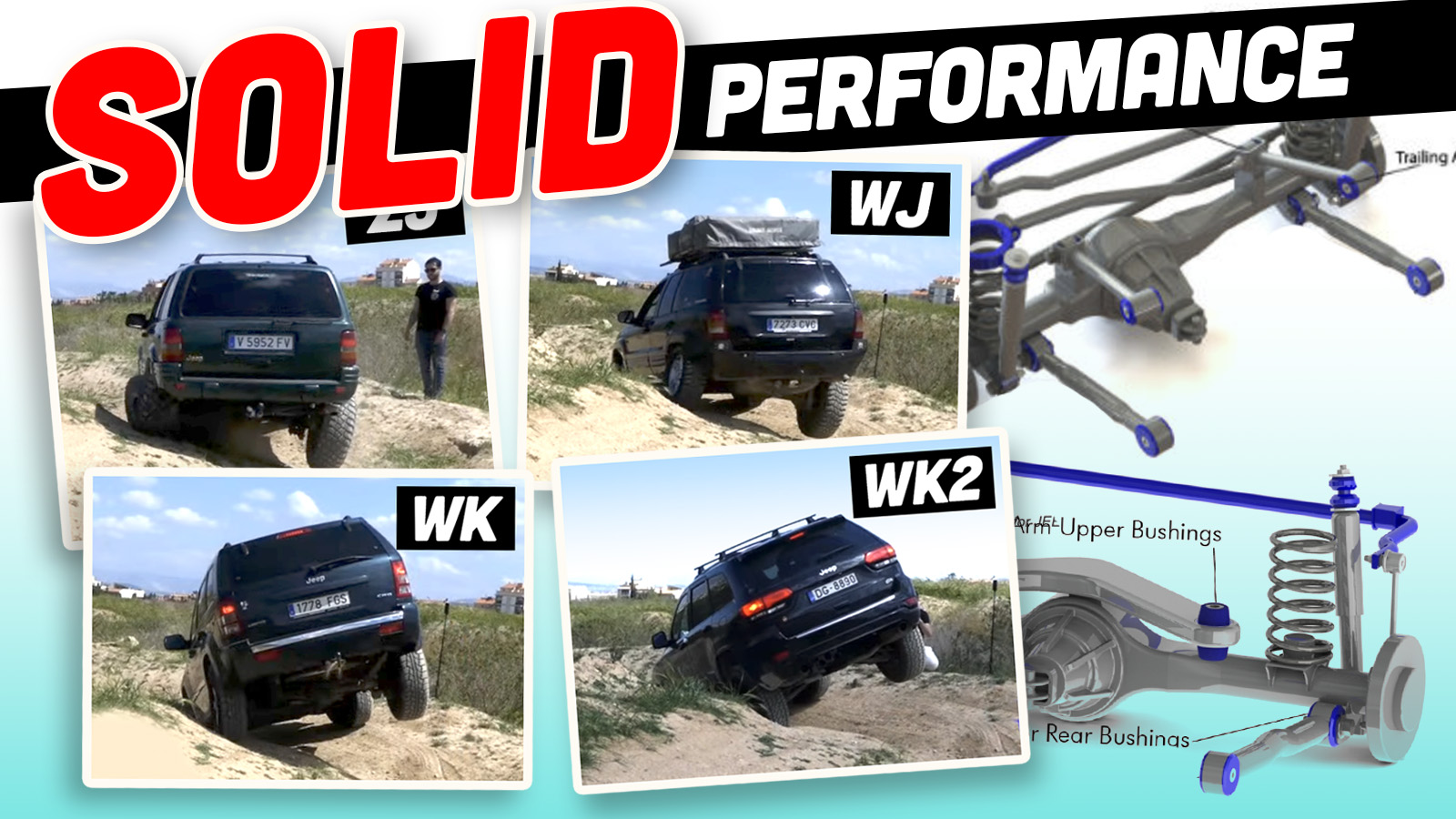






All of them are shown having wheels off the ground proving that solid axles still suck, are uncomfortable to ride in and that they suck. There are no advantages to solid axles besides manufacturers selling you cheap products at a premium
You guys who take what was then a $30,000 94 ZJ (ours a V8 Limited), throw a bunch of parts at them and then beat the crap out of them are just a different breed. I’m impressed with your wrenching driving skills, but I didn’t have the time or money to anything like that. But has been fun to live a little vicariously through you.
I loved my WJ, it outperformed the ZJ and our current WK2 for slow speed offroading, for sure! As for everything else, the WK2 is a great vehicle, going on 160k miles.
Flex from a solid axle on coils just looks so much cooler too.
I miss my ZJ. I had a 97 4.0 with a 3″ lift, 31’s, and a rear drop in locker. With a front suspension that actually articulates, I’d say it was more capable than my 5th gen 4Runner that has crawl control and all that BS.
The only thing that’s a real downer on the ZJ is the axles. You either have a D35 or an oddball D44 with an aluminum center section in the rear, with a D30 in the front. For bigger tires/lockers and hardcore use, an axle swap is really preferable.
Also, once one wants to get much over 3″ of lift, long arms should be considered.
Another vote for Project ZJ! You can do off-road comparisons whenever you add that JL to your fleet.
Out of this batch, I’ve only taken the ZJ and the WK offroad (not in conditions as extreme as shown in the video though). The difference was jarring enough that I was briefly concerned for the WK.
“In fact, the Jeep ZJ would go on to be the only Jeep ever to pair a relatively lightweight and stiff unibody design with a fully coil-sprung five-link suspension front and rear.” – has anyone besides Jeep used this setup, or could you extend it to the “only vehicle ever”, not just the only Jeep?
I’ve owned a TJ, XJ, ZJ and WK2. The ZJ was the best Jeep ever made. It was smooth, quiet, comfortable and had legit off road chops as shown in this article. The WK 2 was one of the best cars that I ever owned. Either way, the Jeep engineers did an amazing job with both to serve different audiences.
I’m here for Project ZJ! YOU CAN DO IT!
Thanks for sharing, DT! I have owned and built each of these to some extent, and wheeled them all over the western US.
Started with a ’93 ZJ I-6 manual in the late 90s. Definite upgrade over the XJ, even with manual windows and locks still felt fancy to me. Friends and I geeked out over the similarities between TJ and ZJ suspensions while doing some of my first lifts and learning to wheel.
WJ felt like quite an upgrade at the time but they were long and low compared to the XJ and ZJ. 2″ spacer lift first then 4.5″ suspension and 33s. The rear upper control arm bushing plate bolts on top of the differential were the biggest pain to get.
WK was brief, but then 2 WK2s. Especially in the WK2 I really had to learn to drive on 3 wheels, which happens all the time. With that, learning to work with the limited-slip/traction-control delays and power shifts (lots of 2-footed driving to keep all wheels engaged). First one had standard suspension then got a spring lift, JK Rubicon take-off 32s, skids and rock rails (very key, these are low and drag a lot). Second was a Trailhawk with the air suspension and factory rock rails. Changed out the links to get a little lift for 33s and added more skids. The air suspension was a let down off-road. When in Off-road 1 and especially Off-road 2 settings the suspension would top out ALL-THE-DAMN-TIME, clunking loudly; you lost up-travel and compliance (including articulation).
Still wheeled the WK2s throughout Moab and the rest of southern Utah as well as some of the hardest trails in the Wasatch. They did great for what they were and were all still great for covering miles (and occasionally sleeping in the back).
We need the Torchinsky x Citroen collab here. How would a 2cv Sahara do in this situation?
Make the Citroenian happen!
I used to take my 95 GC to off road parks and events. I had it lifted with bigger tires (31-32in) and sway bar disconnects. The part that hurt the most was the full time transfer case that was open until the 96 model. My 06 commander with IFS was worthless. Now I have a JKU, much better.
I can only imagine the number of people who genuinely wheel a Grand Cherokee is incredibly small, especially since the Wrangler started offering 4 doors. Sure, most Jeeps have gotten softer, but it’s where the market is. The Wrangler & Wrangler Unlimited cover pretty much anyone looking for a Jeep that actually off roads. The modern XJ is just a Wrangler Unlimited, not a Cherokee.
Would it be cool if the GC was actually more hardcore, maybe something more along the lines of a LC250 or even full on J300 or maybe Grenadier, heck yeah. I just don’t think Jeep could actually hit that market on reliability concerns alone. By still offering the Wrangle, 4 door Wrangler, and GC, I think Jeep has found a decent way to cater to either segment with a highly capable & hard core model and also a comfortable, near-luxury experience (lol on that Pentastar), and still include better than market off road capability.
Sure, the solid axle generations have more control, but the WK generations know how to let go, and, if you’re going to party hard, sometimes you have to let go. There’s room in this world for WK jeeps – Andrew would likely agree.
To say the Bronco has made IFS nearly as good off-road as solid-axle Jeeps of yore, is like saying that modern Porsche has made rear-engined deathtraps nearly as good on-road as the mid-engined competitors. Yes, with enough engineering one may overcome each designs’ inherent limits for the application, but only by reinventing a wheel that was already mostly round. Solid axles are not the easiest thing to tame in asphalt, or on washboard gravel that receives occasional scrapes from a county grader, but when the ruts wash out to a third or more of the wheel diameter and distribute randomly between left and right, nothing else compares.
Wait until you see what a solid axle can do with the swaybar disconnected…
I hate to say if but IMHO Jeep was fucked as a function of Chrysler ownership.
I know you are a former Chrysler Engineer and I really appreciate your work as a journalist and whip cracker here, but step back, just look and to the thing that is Stelantis, Jeep is just a high value identity. They don’t even know what they had.
I think you meant to say Chrysler was fucked as a function of Daimler ownership. The first two GCs came out solidly in the ChryCo era even if the first was AMC-derived. ’90s Chrysler was a very good car company. ’00s Chrysler was not, thanks mostly to Mercedes-Benz.
I stand by what I said.
M-B just expedited the withering of the #3 domestic automaker.
Renault wasn’t the cure for AMC either, poor Jeep.
But which gen has trafficators or semaphores?